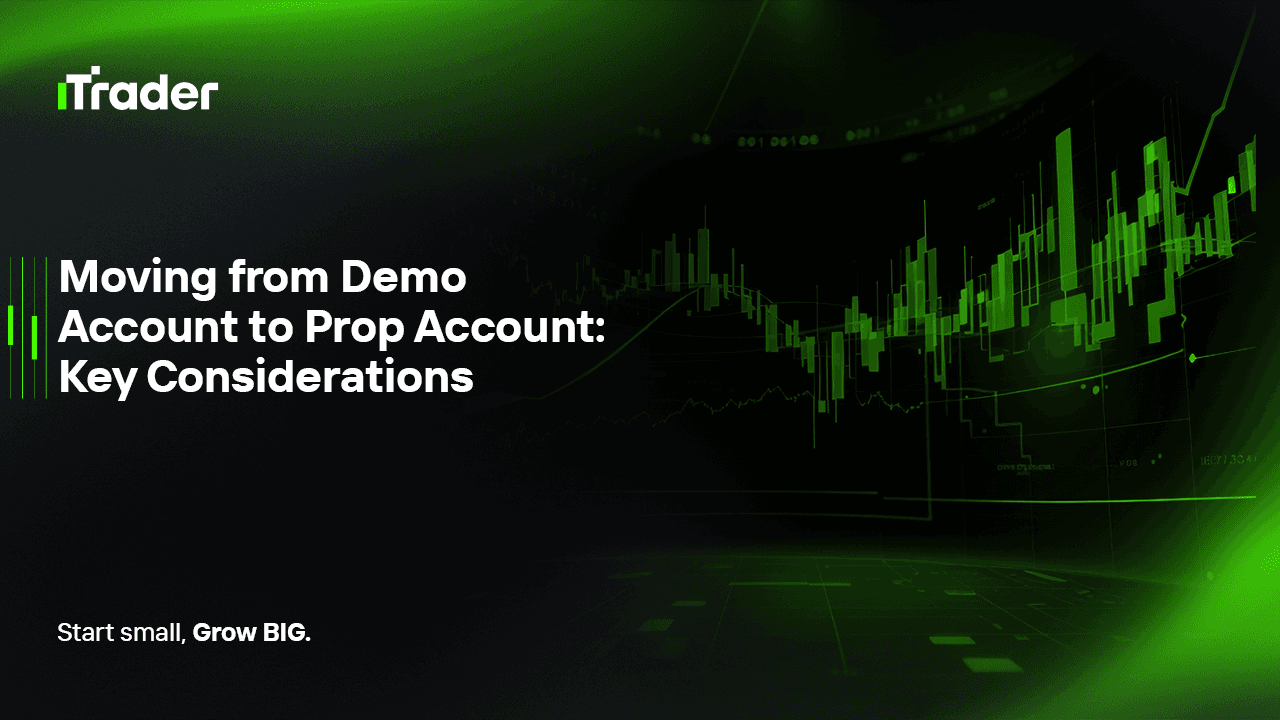2025-09-16
For most aspiring forex traders, the journey begins on a demo account. It’s a safe environment where mistakes cost nothing, strategies can be tested freely, and confidence can be built without the pressure of real money. But at some point, every trader faces the big leap — moving from demo to a prop account, where real capital is on the line and strict rules apply.

This transition isn’t just about proving your technical skills. Prop firms evaluate traders on much deeper levels: risk management, discipline, psychological resilience, and consistency. Passing this phase means showing that you can handle not only the charts but also the emotions, rules, and capital entrusted to you.
In this blog, we’ll break down what you should pay close attention to when making this critical shift, and how to prepare for success in a prop firm environment.
On the surface, demo and prop accounts look similar — you open trades, watch price movements, and manage positions. But the dynamics are very different:
Understanding these differences upfront is essential because many traders stumble not due to lack of skill but due to underestimating the psychological and structural changes.
A demo account is not just for testing whether a strategy “works.” It’s where you build the habits that will carry you through prop challenges. Before attempting a prop account, ensure you’ve:
Think of demo as your rehearsal stage. You don’t pass to the main show (prop account) until you can consistently perform on this smaller stage.
The biggest hurdle in moving from demo to prop is not technical but psychological. When money is real (even if it’s the firm’s), your brain reacts differently:
To manage this shift, you must prepare mentally as much as you prepare technically.
Prop firms don’t care if you make 20% profit in a week. They care if you can protect capital while generating returns. That’s why risk management takes center stage:
In fact, most prop firms would rather see a trader earn 5% with tight drawdowns than 15% with reckless exposure.
The goal in a prop challenge is not to prove you’re a genius trader — it’s to demonstrate you’re a reliable, consistent risk manager. Here’s how to approach it:
Remember: Prop firms are evaluating how you’d handle their money long-term, not just whether you can hit a short-term profit goal.
Moving from demo to prop should not be impulsive. A structured transition plan increases your odds of success:
This staged approach prevents emotional burnout and builds confidence step by step.
Many traders fail prop challenges not because they lack skill, but because they repeat avoidable mistakes:
Awareness of these pitfalls can help you sidestep them.
The demo account is your training ground. The prop account is your audition. Passing it successfully is not the end goal — it’s the beginning of your professional career.
Think of it as stages:
Each stage builds on the previous one. Skipping steps or rushing leads to failure, while gradual mastery leads to long-term success.
Transitioning from demo to prop is one of the most challenging and important steps in a trader’s journey. The skills that served you well on demo — strategy testing, execution practice, risk calculation — now must be reinforced with discipline, emotional control, and strict adherence to rules.
To succeed, remember:
If you respect the process, master your emotions, and trade with consistency, you’ll not only pass prop challenges but also position yourself as a trader capable of long-term growth and professional success.
© 2025 iTrader Global Limited|会社登録番号:15962
iTrader Global Limitedは、コモロ連合のアンジュアン自治島ムツァムドゥのHamchakoに所在し、コモロ証券委員会によって認可・規制を受けています。ライセンス番号は L15962/ITGL です。
iTrader Global Limitedは「iTrader」の商号で運営しており、外国為替取引業務を行う許可を受けています。会社のロゴ、商標、ウェブサイトはすべて iTrader Global Limited の専有財産です。
iTrader Global Limitedの他の子会社には、iTrader Global Pty Ltd(オーストラリア会社登録番号(ACN):686 857 198)が含まれます。 この会社は、Opheleo Holdings Pty Ltd(オーストラリア金融サービスライセンス(AFSL)番号:000224485)の認可を受けた代表者(AFS代表番号:001315037)です。登録住所は Level 1, 256 Rundle St, Adelaide, SA 5000 です。
免責事項: この法人は、本ウェブサイト上で取引される金融商品の発行者ではなく、それらに対して責任を負いません。
リスク警告: 差金決済取引(CFD)は、レバレッジにより資本の急速な損失リスクが高く、すべての利用者に適しているとは限りません。
ファンド、CFD、その他の高レバレッジ商品を取引するには、専門的な知識が必要です。
調査によると、84.01%のレバレッジ取引者が損失を被っています。取引を開始する前に、リスクを十分に理解し、資金を失う可能性があることを認識してください。
iTraderは、レバレッジ取引によるリスク、損失、またはその他の損害について、個人または法人に対して一切の責任を負わないことを明言します。
利用制限: iTraderは、法律、規制、または政策によりこのような活動が禁止されている国の居住者を対象として、本ウェブサイトやサービスを提供していません。